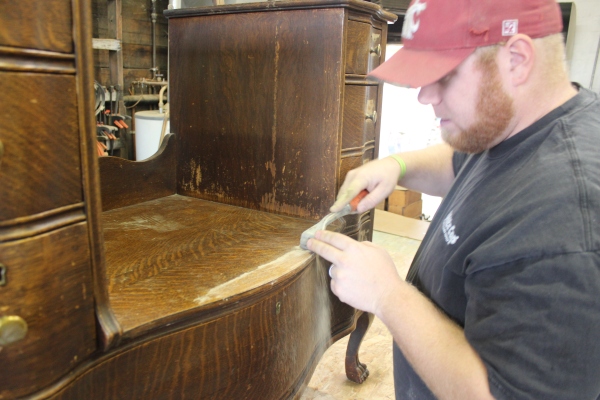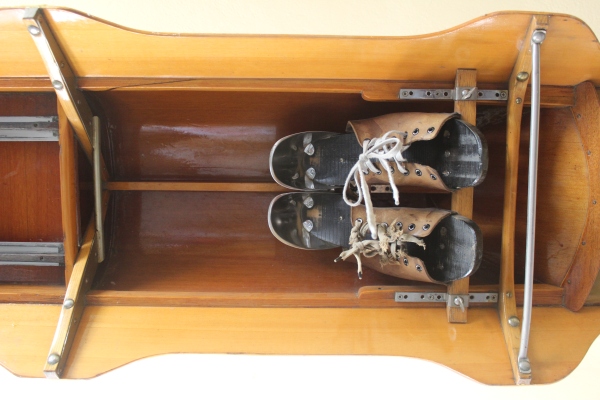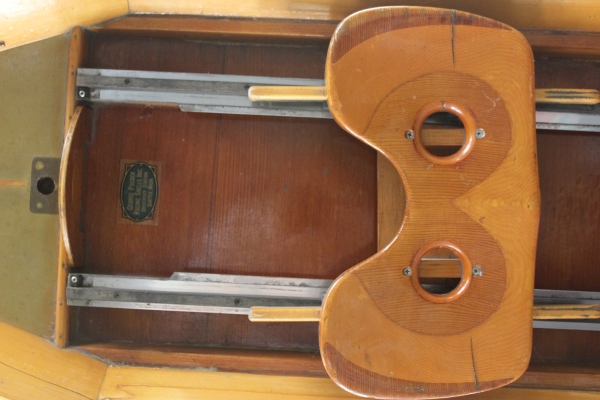What Makes an Antique Shop Great?
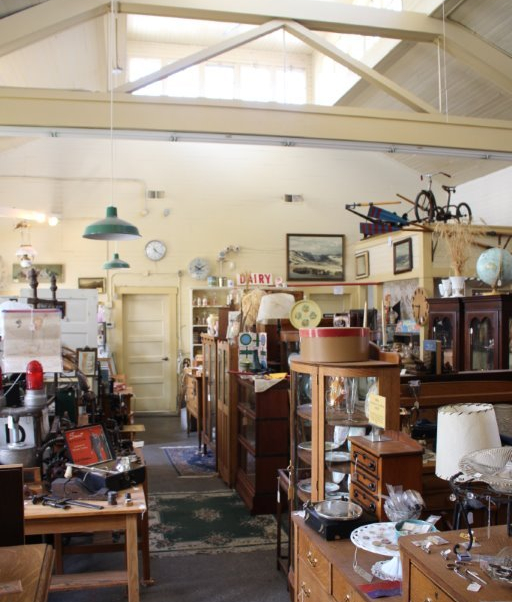
Beam adds an architectural WOW factor
I’m sure that everyone has a different idea of what an Antiques Shop is. Those ideas are based upon each individual’s personal experiences. Generally Antiques Shops are stores that specialize in the selling of antique items.
By definition, antiques are generally considered to be at least one hundred years old. Further the implication is that those items have some special design, decorative, or historical significance. An old item that doesn’t meet these criteria is generally considered vintage and/or collectible.
Essentially there are two types of brick-and-mortar Antiques Shops. Historically the shop keeper owned the business and also owned all of the antiques. Thus the owner controlled the inventory as well as the look and feel of the shop. Our shop, Shady Lawn Antiques, falls into this category; however two of our friends do have some items for sale in our shop.
In the 1980-90s a new Antique Mall business model was developed. In this model, the owner rents out spaces to individual vendors. While the mall owner establishes the overall look of the shop, the vendors are responsible for the inventory, display, and the look of their booth.
During the last forty-five years, we have visited literally thousands of Antiques Shops. The majority of those have been in the ‘band’ that stretches from the mid-west through to the west coast. But we have also visited shops in England, Bulgaria, and Turkey.
Sometimes we were specifically shopping for merchandise. Other times we were conducting “market research”… essentially looking for ideas that we could use to improve Shady Lawn Antiques.
I’ve read travel writers that taste and rate food (hamburgers, for example) as the great, the good, and the not-so-good. That rating scale is certainly subjective, but it could also be applied to Antiques Shops.
Last month, we visited twelve Antiques Shops in the Central Washington and more specifically, the Wenatchee area. Two shops were great, the majority would be considered good, and one might even fall below not-so-good… statistically speaking that breakdown is to be expected.
What do the great Antiques Shops have in common? In short they have a happy vibe… That includes a positive engaging staff and good lighting (natural light is a bonus). They are clean, smell good, and play good/appropriate music.
The quality and selection of antiques is ‘top of the line’ with displays that have a theme and make sense. The price tags and signs give significant information about the item. And last but not least, something about the shop has a positive “wow factor”.
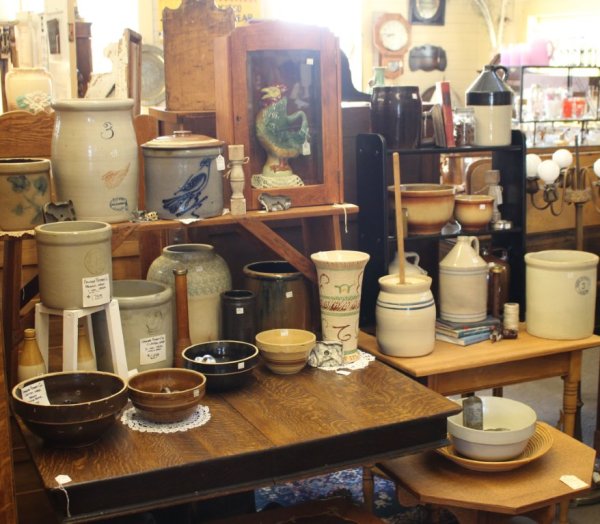
Natural light enhances this themed display of stoneware and crocks.
“Wow factor” as in: wow this building is cool, wow you’ve got such great diversity, wow your furniture is beautiful, and/or wow you have so many unique items (that I’ve never seen before).
Good Antiques Shops might fall short of being great in just one of several ways. The major way is that when shops are too dark, they feel gloomy, and thus might even verge on not-so-good. Another way is when the isles and especially the entrances to booths (and/or rooms) are so crowded that they are hard to enter. The final way is when the inventory is so densely packed that it creates visual clutter and makes it difficult to inspect individual items.
So how does Shady Lawn Antiques rank among Antiques Shops? I have my opinion, but it is uncomfortable for me to rank our own shop. I will say that we are constantly incorporating the best aspects of the great shops that we visit, to make ours the best that it can be.
Walla Walla has many wonderful Antique Shops! If you take the time to visit them, you will be glad that you did! And you will probably even find a treasure along the way…
This column was written for the Walla Walla Union Bulletin in February 2019.
Tips for shopping an Antiques Store

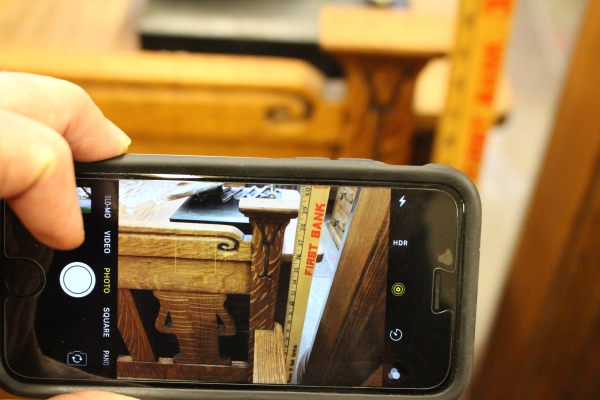 My wife, Jill and I, have shopped and looked for treasures in thousands of different antique stores, shows, and sales. Shopping each type of venue is different but through our observations, we have developed some tips that we are happy to share.
My wife, Jill and I, have shopped and looked for treasures in thousands of different antique stores, shows, and sales. Shopping each type of venue is different but through our observations, we have developed some tips that we are happy to share.
These tips seem to organize themselves into three topics. They include navigating through a store, using the owner as a resource, and making a record of your finds.
Navigating through a store
Shopping studies show that customers seem to automatically turn to the right upon entering a store. We are aware of this at Shady Lawn Antiques, but the only physically logical place for our checkout area is to the right of the door. It is amazing to have people enter the store, see us to the right, and then ask ‘which direction should I go?’
Our response is “which ever direction is most comfortable for you, but most people seem to go left first.” This interaction does actually give us the opportunity to describe the type of items that are located in each section of our store. Since we own our entire inventory, we are able to group similar items together in coherent displays and we can point out their locations.
Jill and I have found that if we really want to see everything in another shop, we will take a second look around. However the second time, we walk around in the opposite direction. Items that are fanned out, staggered, or displayed even at slight angles are more obvious when viewed from a different point of view.
Another tip is to make sure to look at all levels in a shop. It is only natural that shoppers focus most of their attention at eye level. Savvy and/or experienced antique dealers respond to this by displaying their best items at that level.
Sign collectors, however, automatically focus on walls above eye level, because that is where most signs are hung. That being said, one of the best signs that I have ever found (in an antique shop) was on the floor leaning against the wall. I guess that adds credence to the phrase ‘I’ve been looking and high and low…’
Shop owners are a great resource
Don’t hesitate to engage in a discussion with an antique dealer. I have never met one that is a ‘high pressure’ salesman. Owners are proud of their inventory and are happy, perhaps even eager to talk about it. Just ask them “what can you tell me about this piece”?
Let the owner know what you are looking for. There may be one in the shop that you have over looked or they may have one in storage. Antique dealers don’t automatically buy every old thing that they see. So when items are requested, it will increase the chances that the owner will buy one. For me, one of the first indicators of a new trend is when several individuals ask for the same item.
Some owners keep a list of requests and may take your phone number… but don’t just wait for their call, check back with them from time-to-time. This reinforces that you are seriously looking for that item.
If you are looking for a specific type of furniture, it is especially important to talk to the shop owner. For example, we have several dozen pieces of furniture (in storage) awaiting restoration. We are happy to adjust our restoration schedule when we have a request.
Making a record of your finds
So you’ve walked up and down all of the aisles, looked high and low, and found a few things that you would like to think about… there are several methods to record your finds.
The ‘high tech’ solution is to use your cell phone. At Shady Lawn, we encourage people to take pictures of the things that they are interested in. However, it is always polite to ask a shop owner if it is alright to take pictures.
When I am visiting another shop, I like to take a picture of their business card, so that I have contact information. Then I photograph the item(s), along with measurements if necessary. When I want measurements, I will include a tape measure or a yard stick in the picture. Finally I photograph the price tag. It will often have an inventory number and a description that will help in future communication with the shop owner.
The ‘low tech’ method is to draw a sketch and make notes. I normally use my phone but I always carry several 3” by 5” index cards for notes. The cards are convenient because they are a little stiff (and therefore easy to write on) and they fit easily into my check book.
When a Shady Lawn customer asks to borrow a tape measure, I often grab a note pad and follow along. I’ll do a quick sketch and add the dimensions as they are taking them. It is fun and it gives me a chance to use the skills I developed when I was a community college drafting/engineering instructor.
I hope that these tips are valuable to you, on your next antique shopping adventure.
Dave Emigh is the owner of Shady Lawn Antiques and is a fifth generation ‘Walla Wallan’. Glimpses of the ever changing Shady Lawn inventory can be seen on Facebook. Shady Lawn is open for business Wednesday through Saturday from 10am to 5pm.
Typical Week at Shady Lawn Antiques
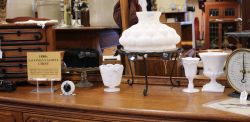
People often wonder what goes on behind the scenes in an antique shop. So I’m going to address that in this column… simply stated: at Shady Lawn Antiques, “We buy some really old stuff and then we hope to sell it”, period.
That is really it, but I’m pretty sure that’s probably not enough information for an entire antiques column.
So I thought about writing about a day in the life of an antique dealer. However any one day can be significantly different than another day. Since the ebb and flow of a week’s work is more consistent, I will address what we do during a typical week when the sales shop is open.
First, you are probably aware that we have just concluded our annual winter antique restoration break. During this six week break, the sales shop is closed. We focus on new inventory acquisition and especially on furniture restoration.
For me, the restoration break is a special time of year. It provides me with an opportunity to reconnect with my creative side. I can often get into a steady work rhythm without a lot of stops and starts. When I’m into that rhythm, each step just flows into the next, without a lot of analysis or thinking. It’s kind of like when an athlete, musician, or artist is ‘in the zone’ and their performance becomes effortless.
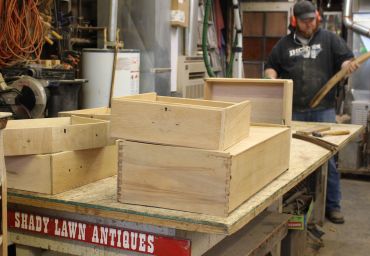 That rhythm all changes when we reopen the sales shop. Planning, thinking, and the clock all once again become important. As in, ‘it’s only an hour until it is time to open the sales shop. I’m not sure if I can get this done and cleaned up…’
That rhythm all changes when we reopen the sales shop. Planning, thinking, and the clock all once again become important. As in, ‘it’s only an hour until it is time to open the sales shop. I’m not sure if I can get this done and cleaned up…’
So back to the statement that “We buy some really old stuff and then we hope to sell it”. We have some tricks that we employ to help sell things. Maybe they should be called techniques, because tricks might seem to imply “smoke and mirrors” and/or doing just enough to get by… but they do call them ‘the tricks of the trade’.
The primary trick we have found is that structurally sound, clean (odor-free) items with clearly marked descriptions sell better. Therefore we structure our work week in an attempt to most effectively acquire, clean, repair, restore, and identify our antique inventory.
We begin each week with a meeting, to plan what we want to accomplish that week. Then we strictly stick to that plan, at least until the meeting is completed. Then almost immediately something unexpected happens and we have to adjust our plans…
That being said, the general flow of our work, on a weekly basis, is pretty similar. The sales shop is closed on Monday and Tuesday. So those days are reserved for furniture rearranging, maintenance, and/or restoration projects; especially those projects that are best done by several people working together.
Wednesdays through Fridays are hybrid days where we put effort in both the work shop and the sales areas. Our customer flow is a little less on these days (than on the weekend). So that is when we do research on items, price them, and then display them. Remember that we have found items with clearly marked descriptions sell better. So we try to provide the manufacturers name, pattern name, and the age of each item on our price tags.
Early each week, we thoroughly clean every newly acquired “small item”. In the antiques trade, the term “smalls” includes anything that is not furniture. Many of these items get specially cleaned by hand but some can include a trip through the dishwasher. We have found that one trip through a short dishwasher cycle, with a small amount of soap does not hurt most pieces of glassware or pottery. It is the long term repeated dishwashing that will ultimately harm these items.
Fabric will be washed if possible and then ironed. Leather is cleaned and conditioned with quality products. Metal items receive appropriate treatment depending on the item and its condition. Elbow grease makes a significant impact on the preparation of small items for our shop.
The flow of restoration, for furniture pieces, seems to be most efficient when we begin the week with an empty shop. Monday through Thursday noon is dedicated to our ‘dust producing activities’. These include disassembly if it is necessary as well as cutting replacement pieces such as drawer runners and drawer bottoms. Early in the week we sand the pieces in preparation for their new finishes.
Generally we will have several pieces in process at the same time. With several projects in the pipeline we can work on one piece while we wait for the glue to dry on another. There are some projects that do not require removing the finish. They may need only minimal gluing. Then we clean the surfaces and we can get them out into the showroom one step earlier.
Thursday afternoon is our preferred time to put finish on our projects. So after lunch, we dust and clean the shop and then apply finish on each project. During cold weather, we leave the shop warm overnight to enable the finish to dry and cure. Then on Friday we can reattach glass, mirrors, hardware, and doors to complete the project. This reassembly takes a surprising amount of time.
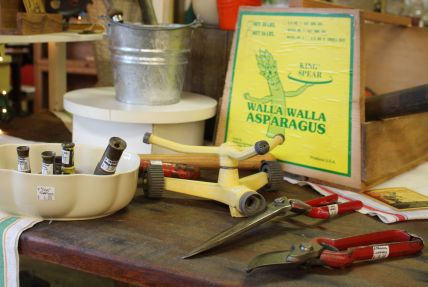 Each week we also focus on one area of our sales shop. We ‘deep clean’ the area and refresh the displays. This may occur as a result of new inventory acquisitions or changing seasons. A recent example of this is a new display that incorporated spring pastel colored items with gardening items.
Each week we also focus on one area of our sales shop. We ‘deep clean’ the area and refresh the displays. This may occur as a result of new inventory acquisitions or changing seasons. A recent example of this is a new display that incorporated spring pastel colored items with gardening items.
In summary, as a result of our effort, each week you will find several new pieces of furniture and a newly refreshed display at Shady Lawn. In addition, a variety of new small items are displayed daily.
Walla Walla is fortunate to have a number of great antique shops. If you visit one this week, you won’t be disappointed!
Dave Emigh is the owner of Shady Lawn Antiques and is a fifth generation ‘Walla Wallan’. Glimpses of the ever changing Shady Lawn inventory can be seen on Facebook. Shady Lawn is open for business Wednesday through Saturday from 10am to 5pm.
New Year Business Plans at Shady Lawn Antiques

Each year we close Shady Lawn Antiques from Christmas until mid-February, which this year means Valentine’s Day. We take the first week off work completely and then on January 2nd we begin restoring furniture in our workshop. During this time we also review the previous year’s business and create a plan for the New Year.
This year the business review was pretty straight forward. In 2017 we had a big growth in sales; we restored and sold the most pieces of furniture ever; and even so, ended 2017 with the best year-end inventory ever. Our growth was in a year that Ron Williams, executive director of Visit Walla Walla, reported that tourism was flat and showed no growth.
So you might say that there is not much for us to review… that we should just keep doing what we are doing. Not so fast, there are always lessons that can be learned and plans that can be refined, even in the midst of business growth.
The starting point for our annual business evaluation is a review our business plan. As a part of that plan, our philosophy is to acquire the most unusual and unique small items and the highest quality antique furniture. Then clean and/or restore them so they are presented in ready to use condition. As we like to say “we never want to have to make an excuse for anything that we sell”.
The focus of this year’s review was on furniture because it accounted for the majority of our income. Further, the 150 pieces of refinished oak furniture in our inventory consume the majority of our floor space. Therefore we were especially interested in determining if there were ways that we could more efficiently restore furniture to enhance our already strong inventory.
I think that a review of the evolution of our business would provide some insight into how we determined this year’s business priority.
Several years ago we realized that we simply did not have enough room for every piece of furniture that we had the opportunity to purchase. So we decided to focus on oak furniture, which we love for its strength, character, and the rich warm glow it provides in any setting. We felt that we would have a more coherent inventory and that we could provide greater depth in choices.
For example, if someone is looking for a buffet, we currently have eight different styles and sizes available. In short, our plan was to establish Shady Lawn Antiques as the go to source for restored oak furniture in SE Washington.
If we are not there already, we are close. Late last year we sold five pieces of furniture to a couple that live in Pullman. They said “in our area we can only find a piece here and there. We like your selection, options, and the fact that we can buy everything in one place.” A customer from Richland bought four pieces of furniture. She said that she liked how all of our oak pieces have a matching finish.
As a result of a year-end review several years ago, we developed a specific color and finish that we now use on all of our oak pieces. Further we made a long term commitment to maintaining that finish and look. That way each piece in our inventory is visually compatible with each other. Pieces that are purchased several years apart will also match each other.
During our restoration process we hate to use chemical furniture strippers. This is both a personal health as well as an environmental health decision for us. Anyone who has stripped a good sized dresser, with a mirror, and fancy trim knows that it takes about a gallon of stripper to complete the job. Yes, we occasionally have to strip something but we have only used a half a gallon of stripper in three years.
That being said, power hand sanders are the most important tools in our restoration shop. We regularly use oscillating power hand sanders for hours at a time. By the end of last year, it became apparent that the hand, wrist, and forearm fatigue that their vibration was causing wasn’t sustainable for the long term.
During our year-end review, we determined that our number one priority was to upgrade our sanding capabilities. Following extensive research, we found a sander that had been on the market for just a year. It was new enough to be ‘state of the art’, but old enough to have a record of proven success and reliability.
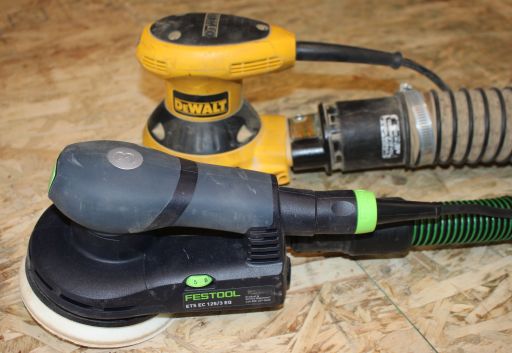
The sander has a brushless motor which delivers more power and is vibration free. Woodworking industry tests revealed that it was twenty-five percent faster at ‘product removal’ than the sander that we were using. That was enough for us to look further into this sander.
Unfortunately the sander wasn’t available locally, or even in the Tri-Cities, so we took a trip to Spokane to check it out. We were pleased with the sander and several thousand dollars later, we owned a complete sanding system.
It includes a random orbital sander and a sander with a 90 degree head (that will sand two perpendicular surfaces at the same time). The sander is connected to a dust removal system that starts automatically when the sander is turned on. Also included were an overhead boom arm to keep the dust removal hose off of the work bench, and a full selection of sanding discs. It is a significant upgrade from the seventy-five dollar power sanders that we were using.
We have already completely sanded four pieces of furniture with our new system and we are really pleased with how quietly and smoothly it works. While the finished furniture doesn’t look different, our hands and arms sure feel better.
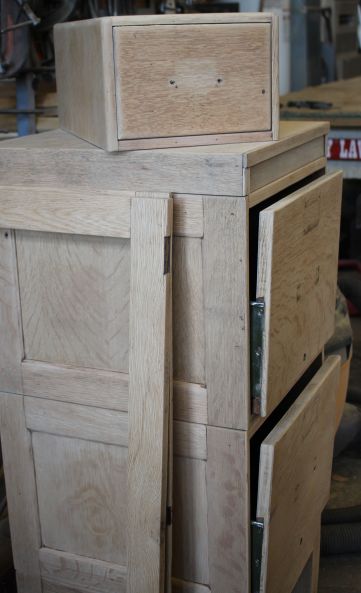
Perhaps we are still just doing what we were doing last year. However this year we are doing it faster, more efficiently, and more comfortably.
Dave Emigh is the owner of Shady Lawn Antiques and is a fifth generation ‘Walla Wallan’. Glimpses of the ever changing Shady Lawn inventory can be seen on Facebook. Shady Lawn Antiques is currently closed, but will reopen on February 14th. Shady Lawn is normally open for business Wednesday through Saturday afternoons.
Antiques, Nostalgia, and the Holidays
I wrote this article as a part of the series that I write for our local newspaper, the Walla Walla Union-Bulletin. The series focuses on antiques as seen through the focus of our Shady Lawn Antiques business. This article was published on Sunday, December 6, 2015.
The Holidays are perhaps the most nostalgic time of the year. They are a combination of: family, friends, traditions, customs, religion, and memories of the past.
Each year when people open their plastic storage totes and pull out the first decorations, the memories of Holidays also waft out. It seems that most everyone has at least one of grandma’s antique decorations tucked away. Thus antiques and the holidays are intertwined even if you never thought about it that way.
At Shady Lawn Antiques we have noticed that antiques are always popular during the holidays. Early in the season people are upgrading their home furnishings before they do their entertaining. In fact one couple annually buys one large piece of antique furniture for their home as a gift to each other.
We are seeing a growing trend of displaying antique Christmas decorations in non-traditional ways. For example a complete set of glass ornaments maybe displayed in its original box and not even put on a tree. Ornaments are also being displayed in clear glass bowls and on trays. Another trend is toward decorating several small (under two foot) trees, each with a different theme.
Customers tell me that they are delighted to give and receive antique items. They believe those gifts show that thought and care was given to finding and selecting them. They say that antiques, by virtue of their longevity, have demonstrated their quality of construction and materials.

Circa 1930s felt body, composition head Santa
My friend, Doug, often comes into SL and says ‘tell me a story’. Well here are some Shady Lawn holiday shopping stories… Perhaps one of greatest male shoppers that I have ever known brings his wife through SL each fall. While they discuss what they like, he makes mental note and then ‘sneaks’ back for the ultimate surprise gift. (Once he even talked me into delivering a piece of furniture at seven in the morning for an anniversary surprise.)
Perhaps my favorite antique gift idea is both creative and inexpensive. We have several individuals that purchase fancy individual china plates. They put homemade cookies and goodies on them and give them away, plate and all.
Each year we have people that purchase large items and leave them at SL until Christmas Eve so they can be a surprise. One year I had to tell a woman that I had sold the item that she was looking at (even though I had sold it to her husband)…
Another woman likes to buy one antique Christmas tree ornament each year. It is a fun challenge for her to find one that is different from what she already has.One family has ‘moved beyond individual gift giving’ but still likes to decorate a Christmas tree. They put a train and antique toys from their youth (or earlier) under the tree as decorations.
We have a family that has comes in every year on the hunt for the perfect Christmas stocking stuffer. Their tradition is that it has to be an antique that is priced under $5. I am always amazed at what they find!
Please take time to visit our locally owned great Walla Walla antique shops this holiday season. You will enjoy the nostalgia and great offerings away from the hustle bustle and the bright lights of the big stores.
Dave Emigh is the owner of Shady Lawn Antiques and is a fifth generation ‘Walla Wallan’. He writes about antiques and life in the ‘Valley of the Two Wallas’ on his blog: http://www.wallawallalocal.wordpress.com. Glimpses of the ever changing Shady Lawn inventory can also be seen on Facebook.
Blogs… Technology, Social Media, and the Changing Times
 I began writing this blog to tell the story of life in Walla Walla, Shady Lawn Antiques, and perhaps a bit of family life. The blog was fun and was serving its purpose very well… and then the iPhone and Facebook came along. The ease of taking a picture and making a quick Facebook post with an iPhone makes it that much more difficult for me to sit down at a computer to write a longer blog post. Then just when I’m comfortable with Facebook, my children tell me that I should really be on instagram…
I began writing this blog to tell the story of life in Walla Walla, Shady Lawn Antiques, and perhaps a bit of family life. The blog was fun and was serving its purpose very well… and then the iPhone and Facebook came along. The ease of taking a picture and making a quick Facebook post with an iPhone makes it that much more difficult for me to sit down at a computer to write a longer blog post. Then just when I’m comfortable with Facebook, my children tell me that I should really be on instagram…
I have also been writing an Antiques Column for our local paper, the Walla Walla Union Bulletin. The WWUB calls it an occasional column. In my mind it is monthly, but in reality the WWUB is correct.
My interest, or motivation, or ? for writing a blog has diminished due to the combination of writing longer columns for the newspaper and shorter Facebook posts. It has therefore been months since I have written a blog post.
Moving forward, I may not be making many original blog posts but I do hope to be more diligent in posting my WWUB articles here. If you would like to see more frequent updates I would suggest that you “like” Shady Lawn Antiques on Facebook and follow me there. I think that you can link to my Facebook posts (if you are not a registered Facebook member) through the Shady Lawn Antiques website.
My next post will be my latest WWUB column and then I will post previous columns… BTW I’m still not on instagram.
I wrote this article as a part of the series that I write for our local newspaper, the Walla Walla Union-Bulletion. The series focuses on antiques as seen through the focus of our Shady Lawn Antiques business. This article was published on Sunday, March 1, 2015.
 Twenty Years of Shady Lawn Antiques
Twenty Years of Shady Lawn Antiques
We have just completed our twentieth year of selling antiques in the butterscotch yellow colored Shady Lawn Creamery buildings. The buildings were not always this color and the family business was not always antiques.
My great-grandfather, Ward Emigh, purchased the Walla Walla Creamery 1897. When his son John took over in 1922, the business was renamed Shady Lawn Creamery. It continued to operate as a creamery until my mother, Mary Emigh retired. My wife Jill and I purchased the industrial gray Shady Lawn Creamery buildings and opened the antiques shop in December 1994.
One hundred and eighteen years later the Emigh family is still doing business in the same location. The exterior industrial gray building color did not reflect the vibrant antique business that was being conducted inside so we looked for an alternative. A butterscotch yellow 1920-30s metal Shady Lawn Ice Cream sign provided a historically sensitive inspiration and the color match for the new exterior paint scheme.
Each year we take stock of where our business is and what we would like to accomplish in the year to come. The completion of twenty years in the antiques business has prompted me to reflect upon the state of the antiques business in general and specifically the trends over the past twenty years.
The antiques business was significantly different twenty years ago. There were still a large group of people that collected categories of things and were always looking to add something they didn’t have to their collection. We used to hear ‘I collect: dolls, cookie jars, cut glass, depression glass, Roseville pottery, metal spice or tobacco containers (tins)’, and so on. Some people only collected one category but many had several interests.
When we opened Shady Lawn Antiques the antique mall concept was quite popular. The idea was that the mall owner would rent each dealer a space and then also collect a commission on the sales. The mall owner ran the shop and the dealer’s responsibility was to keep their booth arranged and stocked. The theory was that with more dealers, more new inventory would be available.
Since we had more building space than we had antiques to sell, we opened Shady Lawn as an antique mall. Over time we acquired more things and especially more large pieces of furniture. As dealers moved on for one reason or another, we took over the space. From a humble beginning of perhaps one hundred items, our inventory now numbers in the thousands.
The antiques show circuit was strong and vibrant when we began in 1994. There was at least one show per month somewhere in the state. Several of the more prestigious shows had more than two hundred vendors and they even had a waiting list of new vendors that wanted to get in.
Then the advent of the internet and especially eBay sparked the biggest single change in the antiques market ever. Suddenly items that were considered rare could be found on a regular basis. People no longer had to ‘snap something up’ right when they found it. The shows and shops that emphasized collectible, generally small, items began a steady decline. I’ve often heard long time dealers say that the antique business just isn’t the same anymore and it isn’t!
There is still a market for truly unique and especially historical items but the current trend is toward functional and decorative items. The majority of our showroom is now dedicated to fully restored oak furniture and in fact we have the largest selection in Eastern Washington.
We also began building functional and whimsical furniture from reclaimed materials over ten years ago, well before the current upcycled and industrial design trend began. Individuals and wineries are incorporating these pieces, as functional statement pieces, into their own unique styles.
Shady Lawn Antiques has grown and evolved over the past twenty years. We look back at the collectibles era with a bit of nostalgia but we look ahead with even greater excitement to the new Pinterest Look era! We still have a passion for restoring and saving antique furniture but have an even greater passion for the future. We are proud to have been ‘Makers’ even before the advent of the recent ‘Makers Culture’ trend began.
Dave Emigh is the owner of Shady Lawn Antiques and is a fifth generation ‘Walla Wallan’. He writes about antiques and life in the ‘Valley of the Two Wallas’ on his blog: http://www.wallawallalocal.wordpress.com. Glimpses of the ever changing inventory can also be seen on Facebook.
I wrote this article as a part of the series that I write for our local newspaper, the Walla Walla Union-Bulletion. The series focuses on antiques as seen through the focus of our Shady Lawn Antiques business. This article was published on Sunday, January 18, 2015.
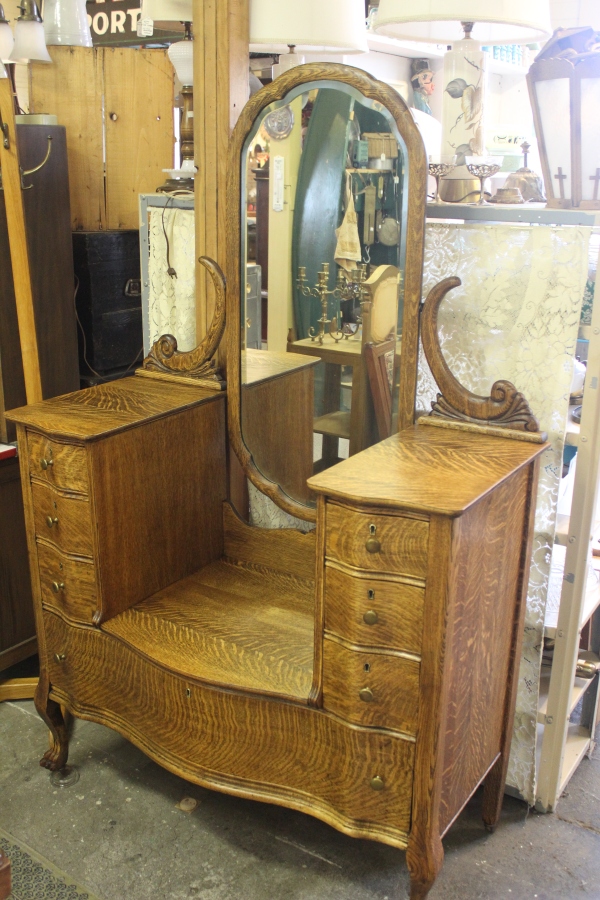
Recently restored early 1900’s Oak Vanity. No power tools or any chemical strippers were used during the restoration.
New Year at Shady Lawn Antiques
January marks the beginning of the New Year at Shady Lawn Antiques but it hasn’t always been so. My wife Jill and I were both educators before we opened Shady Lawn and as such, the New Year always began in September. It only took a year in business before our sense of the New Year was reset to the spring. In the spring the weather got nicer, people began cleaning out their storage and a bigger source of ‘new’ inventory became available. There was also just a general ‘stirring’ as people started getting out going to antique shops and to the (then widely popular) antique shows.
Over a period of the last ten years our business has evolved to the point where Shady Lawn has become known for high quality antique furniture. Adding to this recognition is our philosophy that every piece of furniture we sell must be ready for immediate use. That is, it must be both structurally and cosmetically sound without any defect that we must apologize for. The restoration of furniture to that quality level takes a significant amount of time.
Further, major restorations take big hunks of uninterrupted time. So several years ago, we took the gamble that we could close the sales area from Christmas until February to restore furniture and that we could ‘make-up’ the sales later in the year.
Further we also found that a Wednesday through Saturday sales ‘week’ seems just as effective for our type of business. So furniture restoration is now also the focus on our ‘closed days’ of Monday and Tuesday. It should be noted that we only restore our own furniture and we do not offer restoration as an option for the public.
We are currently in the midst of our winter closure and our furniture restoration binge. Fortunately this change of pace invigorates me. I enjoy the mental challenge of creating solutions to the problems that are inherent in every restoration. It is also a physical challenge to see how much we can accomplish… if we are not going to be open to sell things we’d better get something ready to sell.
This daily schedule of focusing entirely on woodworking also sparks my creative side. My thought process just naturally flows from the project at hand to designing my next re-purposed wood project/creation. A re-purposed wood and metal table design is percolating in my mind and may pop out as a finished project before we reopen…
Our current focus is on working through the restoration of some oak storage cabinets we acquired this past year. Then we will select a few of the more unique pieces of furniture from our archival storage to restore.
With the more ‘furniture forward’ business model our sense of the New Year now corresponds directly with the calendar. We start our New Year by building up our inventory so we have an interesting mix of new items for our customers to see. We organize our new items into interesting coherent displays and then open in February for our New Year! Until then you can monitor our progress on Facebook at www.facebook.com/ShadyLawnAntiques .
Dave Emigh is the owner of Shady Lawn Antiques and is a fifth generation ‘Walla Wallan’. He writes about antiques and life in the ‘Valley of the Two Wallas’ on his blog: http://www.wallawallalocal.wordpress.com.
Walla Walla Union-Bulletin Antiques Article… The Boys in the Boat
I wrote this article as a part of the series that I write for our local newspaper, the Walla Walla Union-Bulletion. The series focuses on antiques as seen through the focus of our Shady Lawn Antiques business. This article was published in the late Fall of 2014.
The Boys in the Boat – and the George Pocock Wooden Racing Shell
Antiques, fine woodworking, and rowing are three of my great passions and for the most part they are unrelated. However they have recently become intertwined…
The book, ‘The Boys in the Boat’, was recently named as number one on the New York Times nonfiction bestseller list. It was written by Daniel James Brown. The book tells the story of nine University of Washington rowers and their quest for the Gold Medal in the 1936 Berlin Olympics.
A prominent figure in the book was George Pocock. He was a third generation racing shell (boat) builder. Brown describes that during the 1930’s, Pocock built shells in the UW boathouse and that he was an advisor to the coaches and to the oarsmen.
Pocock was a religious man but he also felt a strong spiritual connection to rowing. By the time that I began rowing in the 1970’s it was evident the rowing community also had a strong connection to Pocock. He was held in such high esteem that when any rower used the single name George, it was automatically assumed to be Pocock.
This summer people began coming into Shady Lawn Antiques to see the Pocock cedar racing shell that is hanging from the ceiling, in the back of the shop. I was a bit puzzled about the sudden interest because the shell had been hanging there for twenty years.
It turned out that there were at least two book clubs in Walla Walla that were reading ‘The Boys in the Boat’. They were interesting in seeing a racing shell that George Pocock had built… so here is the story of my shell.
I ordered a single scull (one-man racing shell) from Pocock Racing Shells, Seattle in 1974. By that time George’s son, Stan, was in charge of the daily operation of the company. George continued to build the single sculls and he completed mine when he was 83 years old. My scull is one of the last three that George built.
It is made from a single plank of western red cedar that is over 26 ½ feet long. The completed single weighs approximately thirty-five pounds with the seat and riggers (to hold the sculls). The design of the Pocock racing singles was unchanged for over fifty years making my shell appear to be even older than it is.
By the 1980s racing shells were no longer made of varnished wood and an era had passed. In the Antiques World an item tends to be called an “antique” when the design, the method of manufacture, or the construction material changes. By that definition, my cedar single has become an antique and my passions are being woven more closely together.
The single is now forty years old and it has been rowed well over five thousand miles. Even so, the attention to detail and the quality of George’s craftsmanship are still clearly evident. George is/was an inspiration to me not only as a rower but also as a fine woodworker/craftsman.
“for him (Pocock) the craft of building a boat was like religion. It wasn’t enough to master the technical details of it. You had to give yourself up to it spiritually; you had to surrender yourself absolutely to it. When you were done and walked away from the boat, you had to feel that you had left a piece of yourself behind in it forever, a bit of your heart.”
― Daniel James Brown, The Boys in the Boat: Nine Americans and Their Epic Quest for Gold at the 1936 Berlin Olympics
Please come into Shady Lawn Antiques and see my George Pocock built, varnished western red cedar, racing shell. It is truly a work of art!
Dave Emigh is the owner of Shady Lawn Antiques and is a fifth generation ‘Walla Wallan’. He writes about antiques and life in the ‘Valley of the Two Wallas’ on his blog: http://www.wallawallalocal.wordpress.com.
Stan Pocock was 91 years old when he died December 15, 2014. Less than a month earlier a relative of his came into Shady Lawn to look at antiques and commented on the racing shell. He told me that his cousin was married to Stan. He then called his cousin and when Stan was on his cell phone, he handed it to me. I was fortunate to be able to tell him how impressed the readers of the book are with George, the Pocock family, and their outstanding racing shells. I told him about the (this) article that I had written. Stan said that the workers in his shop always called his father Mr. George, out of respect. He also mentioned that the book was so well written that the race descriptions gave him a tingle of excitement even though he knew the results.
I feel fortunate to have had the opportunity to have had one last conversation with a truly humble and distinguished legend of rowing.
the Colors of Fall in Walla Walla…
In the past I have posted an number of photographs from my walks to and from our store, Shady Lawn Antiques, here in Walla Walla. This Fall I have been walking around our neighborhood a lot.
The Fall colors in WW are always outstanding but they don’t often last as long as they have this year. We just had our first frost last night which is a full month later than the average first frost.
The houses in our neighborhood are all well over 100 years old and so are many of the trees. Mixed in are a number of newer trees that have been planted as future replacements for the stately old trees. The newer trees are smaller and that makes it easier to get some nice close-up pictures of the leaves.



